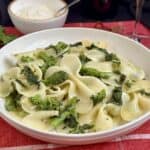

Rapini Pasta ( 4 Ingredient Recipe, Ready in Minutes)
A simple, delicious and nutritious, 4 ingredient pasta dish that's ready in minutes.
Equipment
- 1 Staub cast iron sauté pan
Ingredients
- 1 lb pasta (good quality)
- 4 Tbsp extra virgin olive oil plus more
- 3 cloves garlic
- 12 oz rapini
- ⅛ tsp hot pepper (optional)
- ⅛ tsp salt to taste
- 8 oz Italian sausage if in links, remove the casing (optional, omit for vegan)
- 1 tsp Pecorino Romano DOP to taste (optional)
Instructions
- Put a large pot of water on the stove to cook the pasta, and bring to a boil. While waiting for the water to boil, prep the rapini.
- After washing the greens, cut the lower stems off the rapini (which are too tough to eat), and discard. Better yet, compost these stems if you can. NOTE: do not dry the rapini.
- Next, slice into the bottom of the thicker stems about an inch or so, so that they cook more evenly. Chop the rapini into one or two inch pieces. I'm using a Staub cast iron sauté pan.
- Now pour the olive oil into a large sauté pan over medium high heat. When it gets hot, toss in the garlic and hot pepper, if using. You can use fresh cayenne pepper or hot pepper flakes, as well.
- After a minute or so, carefully add the chopped rapini. Because the water is still on the greens, the oil will spark, so try to cover the entire pan quickly.
- Put the lid on immediately, then add about ⅓ cup of water, stir quickly, and put the lid back on.
- When the water is coming to a boil, add 2 teaspoons of salt, then add the pasta and stir well. Cook as directed on the package (all pasta cooking times vary). Taste the pasta for salt when it's close to being ready. Add more salt if needed.
- Salt the rapini with a sprinkle of sea salt (you can always add more) and let cook for about 3 minutes before checking for doneness and seasoning. The stems should be tender, but not soft. Turn and cook as long as needed, then remove from heat and take off the lid to hinder them cooking further.
- Drain the pasta when it's al dente (still has a little bite in the center), but reserve some pasta water. Put the rapini pan over low heat, then add the pasta and carefully combine them, adding more extra virgin olive oil and pasta water as needed. You don't want a dry pasta, so be generous with both; just add a little at a time and taste as you go.
- Serve along with grated Pecorino Romano (be sure to get the real cheese from Italy, if it's marked DOP it's the best).
Notes
- TIP: If pasta is ever too salty when it's cooking, just add more boiling water.
- The amounts of the ingredients are not critical in this recipe, so make it more to your liking. Less pasta, more rapini, more garlic, no garlic, etc. Just use this recipe as a basic guide.
- Nutrition facts include Italian sausage and Pecorino cheese.
Nutrition
Serving: 1 | Calories: 611kcal | Carbohydrates: 71g | Protein: 21g | Fat: 27g | Saturated Fat: 7g | Polyunsaturated Fat: 4g | Monounsaturated Fat: 15g | Cholesterol: 35mg | Sodium: 421mg | Potassium: 458mg | Fiber: 5g | Sugar: 3g | Vitamin A: 1786IU | Vitamin C: 15mg | Calcium: 106mg | Iron: 3mg
DID YOU MAKE THIS RECIPE?Please leave a review by clicking on the RATE button above in the purple header or share a photo and tag @ChristinasCucina on Instagram!